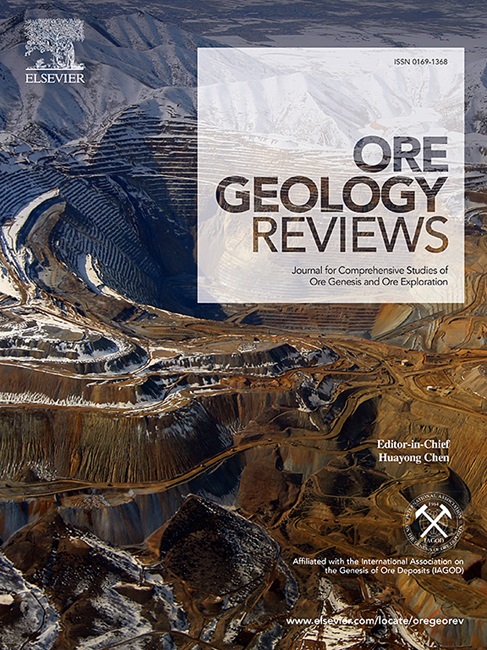Constraining role of organic matter in P-U mineralization: A case study of the Bahuang uranium-rich phosphorus deposit in eastern Guizhou, China
IF 3.2
2区 地球科学
Q1 GEOLOGY
引用次数: 0
Abstract
Phosphorus and uranium are both critical strategic mineral resources, and the potential for developing uranium-rich phosphorus ore deposits is considerable. However, research in this area remains relatively underexplored. The Lower Cambrian black rock series in Bahuang, eastern Guizhou, China, stands out due to its high concentrations of phosphorus, uranium, and organic matter, making it a representative phosphorus-rich deposit. This study investigates the role of microbial organic matter in the mineralization processes of phosphorus and uranium within uranium-rich phosphorite deposits, using the Bahuang deposit as a case study. A comprehensive geological survey was conducted, integrating petrographic analysis, major and trace element testing, rare earth element analysis, total organic carbon (TOC) content analysis, and gas chromatography-mass spectrometry (GC–MS) to systematically examine the geological characteristics, elemental geochemical properties, and biomarker compounds in the organic matter of the ore-bearing rock series. The results indicate that the primary ore minerals in the Bahuang uranium-rich phosphorite deposit are collophane, pitchblende, and uraninite. Pitchblende is absorbed by organic matter, while uraninite is predominantly found along quartz edges and fractures, suggesting a hydrothermal origin. Organic matter is mainly distributed in zones where collophane is concentrated, closely aligning with the spatial distribution of phosphorus and uranium. This organic matter primarily derives from low-grade eukaryotic aquatic organisms, such as algae, and is at a mature to highly mature stage, exhibiting significant degradation. As a result, the TOC content of the ore is reduced, and its correlation with phosphorus and uranium content is weak. The enrichment of phosphorus and uranium is not solely influenced by organic matter content but also by factors such as depositional environment, hydrothermal activity, and the maturity of the organic matter. The ore-bearing rock series formed under sub-reducing to reducing conditions, with significant influence from hydrothermal processes. The ore-forming materials primarily originated from the extraction of continental rift basalt (alkaline basalt and tholeiitic basalt) by hydrothermal fluids, followed by contributions from normal seawater. The phosphorus and uranium mineralization process unfolded in three stages: submarine exhalative activity, which served as the source of phosphorus and uranium; a rise in sea level, which facilitated the upwelling of these elements; and environmental hypoxia, which enabled the precipitation of phosphorus and uranium. During these stages, organic matter influenced the migration and precipitation of phosphorus and uranium in several ways: phosphorus was absorbed by low-grade marine organisms, such as algae, and migrated as phosphate colloids, which precipitated upon reduction by sulfur bacteria; UO22+ was adsorbed and transported by organic acid colloids formed during organic matter degradation or formed uranyl complexes through ion exchange with organic colloids; and uranium precipitated through reactions with reducing gases produced during the degradation of organic matter.

有机质对P-U矿化的制约作用——以黔东巴皇富铀磷矿为例
磷和铀都是重要的战略矿产资源,富铀磷矿开发潜力巨大。然而,这方面的研究仍然相对不足。黔东坝黄下寒武统黑色岩系磷、铀、有机质含量高,是富磷矿床的代表。本文以巴皇富铀磷矿床为例,探讨了微生物有机质在富铀磷矿床中磷、铀成矿过程中的作用。通过岩石学分析、主微量元素测试、稀土元素分析、总有机碳(TOC)含量分析、气相色谱-质谱(GC-MS)等综合地质调查,系统考察了含矿岩系有机质的地质特征、元素地球化学性质和生物标志化合物。结果表明,巴皇富铀磷矿床主要矿石矿物为胶磷矿、沥青铀矿和铀矿。沥青铀矿被有机质吸收,而铀矿主要沿石英边缘和裂缝分布,表明其热液成因。有机质主要分布在胶磷矿富集带,与磷、铀的空间分布密切一致。这种有机物主要来源于低级真核水生生物,如藻类,处于成熟到高度成熟阶段,表现出明显的降解。矿石TOC含量降低,与磷、铀含量相关性较弱。磷和铀的富集不仅受有机质含量的影响,还受沉积环境、热液活动、有机质成熟度等因素的影响。含矿岩系形成于亚还原—还原条件下,受热液作用影响显著。成矿物质主要来源于热液对大陆裂谷玄武岩(碱性玄武岩和拉斑玄武岩)的萃取,其次是正常海水的贡献。磷铀矿化过程分三个阶段展开:海底喷发活动是磷铀矿化的主要来源;海平面的上升促进了这些元素的上涌;环境缺氧,使磷和铀得以沉淀。在这些阶段,有机物以几种方式影响磷和铀的迁移和沉淀:磷被低级海洋生物(如藻类)吸收,并以磷酸盐胶体的形式迁移,磷酸盐胶体被硫细菌还原后沉淀;UO22+被有机物降解过程中形成的有机酸胶体吸附运输或与有机胶体离子交换形成铀酰配合物;铀通过与有机物降解过程中产生的还原性气体反应而沉淀。
本文章由计算机程序翻译,如有差异,请以英文原文为准。
求助全文
约1分钟内获得全文
求助全文
来源期刊

Ore Geology Reviews
地学-地质学
CiteScore
6.50
自引率
27.30%
发文量
546
审稿时长
22.9 weeks
期刊介绍:
Ore Geology Reviews aims to familiarize all earth scientists with recent advances in a number of interconnected disciplines related to the study of, and search for, ore deposits. The reviews range from brief to longer contributions, but the journal preferentially publishes manuscripts that fill the niche between the commonly shorter journal articles and the comprehensive book coverages, and thus has a special appeal to many authors and readers.
 求助内容:
求助内容: 应助结果提醒方式:
应助结果提醒方式:


